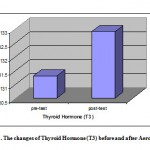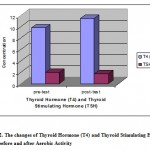Manuscript accepted on : May 30, 2009
Published online on: 28-12-2009
Ali Reza Shahsavar1 and Mohammad Javad Pourvaghar2
1Department of Physical Education, University of Payame Noor (PNU) Amol, 46179-33586, Amol, Iran.
2Department of Physical Education, Faculty of Humanities, University of Kashan, 873117-51167, Kashan, Iran.
Corresponding Author E-mail shahsavar6@gmail.com
ABSTRACT: Triiodothyronine (T3) and thyroxine (T4) are both secreted by the thyroid gland in response to thyroid-stimulating hormone (TSH) secreted by the anterior pituitary gland. This research has been conducted in order to study the changes of secretion of thyroid hormone i.e. (T4), (T3), and (TSH) following an aerobic physical activity. A group of 10 male university athletes with over three years experience in different fields of sport participated in this semi- experimental research. The obtained average and standard deviations of factors such as age, height, weight and body mass index (BMI) are as follows: (23.1±1.65), (171.1±4.51), (68.5±4.8) and (21.4±1.1). The exercise training of this research consisted of 20 minutes of running around the track and field, each being 10 rounds in two minutes. The results showed that aerobic activities did not have any significant effect on amount of T3 and TSH secretion, although the results proved a significant difference in concentration level of serum T4 after 20 minutes (4000 m) aerobic physical activity (p = 0.002). So, it seems that aerobic activities can have different reactions on the secretion of thyroid hormone while factors like hematocrit, plasma decrease, as well as changes in PH of blood and also mental conditions may lead to a significant change in concentration of hormone.
KEYWORDS: Triiodothyronine (T3); Thyroxine (T4); Thyroid-stimulating hormone (TSH); Aerobic exercise
Download this article as:| Copy the following to cite this article: Shahsavar. A. R, Pourvaghar. M. J. The Alteration of Thyroid Hormone and its Stimulating After Aerobic Physical Activity on Male Athletes. Biosci Biotechnol Res Asia 2009;6(2) |
| Copy the following to cite this URL: Shahsavar. A. R, Pourvaghar. M. J. The Alteration of Thyroid Hormone and its Stimulating After Aerobic Physical Activity on Male Athletes. Biosci Biotechnol Res Asia 2009;6(2). Available from: https://www.biotech-asia.org/?p=8669 |
Introduction
The hypothalamic-pituitary-thyroid axis is a complex hormone regulatory system in humans. Briefly, it involves the hypothalamus releasing thyroid releasing hormone (TRH) which in turn stimulates the release of thyroid stimulating hormone (TSH) from the anterior pituitary gland (1, 2, 3). The TSH results in the release of T4 and T3 from the thyroid gland. The TRH is released in response to multiple stimuli, such as, body temperature, stress, dietary intake and some hormone (e.g. catecholamines, oestrogen) changes. Circulating T4 and T3 consist of a portion that is bound to a carrier protein and an unbound, free portion. This latter, free portion, composes less than 5% of the total amount found in the blood, but is the most biologically active form of the hormones (4).
Thyroid hormones are important for maintaining normal physiological function of many body tissues (1, 5, 6). During stressful conditions, growth, reproductive and thyroid axes are inhibited at many levels (7). Nutrition also has a minimal impact except for variation in iodine intake (8). Koistinen (1996) examined the thyroid hormone levels of professional cyclists during a 3-week stage competition. They concluded that serum T4 level showed a significant increase by the last week of competition while concentrations of TSH and T3 remained unchanged (9).
Another study done by Deligiannis et al., (1993) investigating the thyroid hormone response to swimming for 30 minutes at varying water temperatures showed that TSH and T4 levels significantly increased at 200C as compared to 320C but no significant effect was seen on T3 (7). Rosolowska et al., (1998) study on the effects of one week of very intense strength training on the thyroid hormones of male weight lifters showed a significant decrease in TSH, T3 and T4 (10).
The main purpose of the present study was to study the alterations of thyroid gland’s hormones (T3, T4) and also thyroid’s stimulating hormone (TSH) after aerobic exercise in order to clear the existing doubts about the changes in secretion of these hormones after doing this exercise.
Materials and Methods
In this study, 10 male university athletes from different sport’s fields all with more than three years of experience participated in a semi-experimental research. One week before the aerobic exercise, all the subjects passed a thorough health care examination and performed a maximal exercise test on a motorized treadmill. The following data were obtained from these participants:
The average and standard deviation of height (171.1 4.51), weight (68.5 4.8), age (23.1 1.65), body mass index (BMI) (21.4 1.1) and also the variables of heart beat, systolic and diastolic blood pressure (in sitting condition) were measured (table 1,2). Heart rate (HR) was continuously recorded with a portable heart rate monitor (Polar S610, Polar Electro, Kempele, Finland). Before the aerobic exercise test, the subject warmed up on the treadmill, and the appropriate starting running exercise was determined. The running- jugging test to determine VO2 max, was performed. This test has been designed to measure the distance covered during 12 minutes. The subjects were asked to run as much as they could during 12 minutes, however, they were allowed to walk. The aim of this research has been to traverse the maximum possible distance during 12 minutes (11).
The exercise training of this research consisted of 20 minutes of running around the track and field, each being 10 rounds in two minutes. Control of the exercise intensity was done through monitoring the rounds. The mentioned exercise was done at 8 am, at 8-centigrade temperature. In this research the blood samples (5 cc) were drawn from the ulnar vein of subjects before and after the aerobic exercise to measure the T3, T4, and TSH concentration. Radioimmunoassay (RIA) laboratory method was applied to analyze the blood samples.
The archived data from this research was analyzed and statistically through using SPSS software and MS word (2003). Paired – samples T test were used in the statistical analyses depending on the normality of data distribution.
Results
Table number 1 shows mean of subjects, and standard deviation of descriptive variables. Table number 2 shows subjects of T3, T4 and TSH hormones concentration levels, t and P value.
As table 2 shows
The concentration level of serum T3 in pre and post-test after 20 minutes (4000 m) aerobic physical activity is not difference (p = 0.108, df = 9 and t = 1.78).
There is a significant difference in concentration level of serum T4 in post-test after 20 minutes (4000 m) aerobic physical activity (p = 0.002, df = 9 and t = 4.34).
There is no significant difference in concentration level of serum TSH in Post-test after 20 minutes (4000 m) aerobic physical activity (p = 0.707, df = 9 and t = 0.388).
Table 1: Descriptive, Index Mean and Standard Deviation of Subjects (n=10).
| Statistical Index | M | SD |
| Weight (Kg) | 68.5 | 4.8 |
| Height (Cm) | 171.1 | 4.51 |
| Age (Yr) | 23.1 | 1.65 |
| Systole (mmHg) | 9.3 | 1.46 |
| Diastole (mmHg) | 7.3 | 0.95 |
| Body mass index (Cm2) | 21.4 | 1.1 |
Table 2: Statistic Variables of Subject in Pre and Post Aerobic Training, t and P Values.
| Variables | Mean (pre-test) | Mean (post-test) | t value | P value |
| T3 (ng/dl) | 131.3 | 132.9 | 1.78 | 0.108 |
| T4 (µg/dl) * | 9.75 | 11.412 | 4.34 | 0.002 |
| TSH (mIU/l) | 1.936 | 1.734 | 0.388 | 0.707 |
* It is significant in lower than 0.01 level.
 |
Figure 1: The changes of Thyroid Hormone (T3) before and after Aerobic Activity.
|
 |
Figure 2: The changes of Thyroid Hormone (T4) and Thyroid Stimulating Hormone (TSH) before and after Aerobic Activity.
|
Discussion
The purpose of this research was to study the changes of secretion of thyroid hormone (T3), thyroxine (T4) and also thyroid stimulating hormone (TSH) after an aerobic exercise.
Most of the researches have shown changes in thyroid gland’s hormones after doing aerobic exercises. However, some of them might differ from the existing research in the level of intensity or the duration of represented physical exercises.
In this research, no changes were obtained in the concentration of T3 and TSH after 20 minutes of meaningful aerobic exercise. It seems the type of exercise has no effect on the concentration of these two hormones. Since the level of intensity of the mentioned aerobic exercise was not enough to make meaningful changes in the concentration of these two hormones (T3, TSH). In spite of the fact that study has been done on bikers in 3 weeks duration of doing aerobic exercises, the result of the existing research is similar to the findins of Koistinen et al., (1996) (9).
Another was a 30 minutes research on swimmers which was done by Deligiannis et al., (1993) the increase in the concentration of TSH is not similar with the present research and also there has been no change in the concentration of T3 (12).
The study on males’ weight lifters that was done by pakerimen et al has shown decrease in the concentration of T3 and TSH (10), whose was not similar to the result of existing research.
Also the result of this research is similar to the result of Taylor et al., (2004) research which shows that the endurance training causes increase in the concentration of thyroid gland’s hormones (13). We can say that the factors such as concentration of hematocrit, lack of plasma water, concentration of blood’s protein, blood concentration, environment temperature, changes in blood circulation, and decrease in PH and especially increase in secretion of cortisol (10) can cause major changes in thyroid gland’s hormones (10). Another research, done by Ciloglu et al., (2005) has shown increase in the concentration of TSH in less intensive exercises (45% max. heart rate) (14). It seems the lengthy of exercise causes the increase in the concentration of hormones.
In this research the concentration level of T4 had a 17.04% (µg/dl) increase after 20 minutes of aerobic exercise (4000 Meters) which show meaningful changes in secretion of T4 hormone. The effectiveness of the type of exercise on the secretion of T4 can be the reason for the increase of this hormone.
The result of this study is similar to the Koistinen et al., (1996) which measured the secretion of T4 hormone at the end of 3 weeks of meaningful competition (9).
References
- Zarzeczny R, Pilis W, Langfort J, and Kaciuba-Uscilk H., J physiol pharmacol. 47: 503-13 (1996)
- Zhang J, and Lazar MA., Annu Rev Physiol. 62: 439 – 466(2000).
- Langton JE, and Brent GA., Endocrinol Metab Clin North Am. 31:159–172 (2002).
- Danzi S, and Klein Irwin., Current Hypertension Reports. 5: 513 – 520 (2003).
- Baylor L S, and Hackney A C., Eur J Appl Physiol Springer-Verlag. 88: 480–484 (2003).
- Douyon L, Schteingart DE., Endocrinol Metab Clin North Am. 31:173–189 (2002).
- Bondanelli M, Chiara Zatelli M, Rosaria Ambrosio M, and degli Uberti E C., Systemic illness. Pituitary. 11:187–207 (2008).
- Fisher D A., Clinical Chemistry. 42, 135 -139 (1996).
- Koistinen P, and Martikkala V. J sport med phys fitness. 36: 408 -11 (1996).
- Rosolowska-Huszcz D. J., physiol pharmacol. 49: 457 – 66 (1998).
- Pourvaghar MJ., Gazzetta Medica Italiana. 167: No. 3 105- 108 (2008).
- Deligiannis A, Karamouzis M, and Koudidi E., Br J Sports Med. 27:247-50 (1993).
- Taylor SM, Walter CL, and Carr AP., American Journal of Veterinary Research. 65: No.3 333-337 (2004).
- Ciloglu F, Peker I, Pehlivan A, Karacabey K, and Ilhan N., Neuroendocrinology letters No.6 December, vol.1 .26 (2005).

This work is licensed under a Creative Commons Attribution 4.0 International License.





